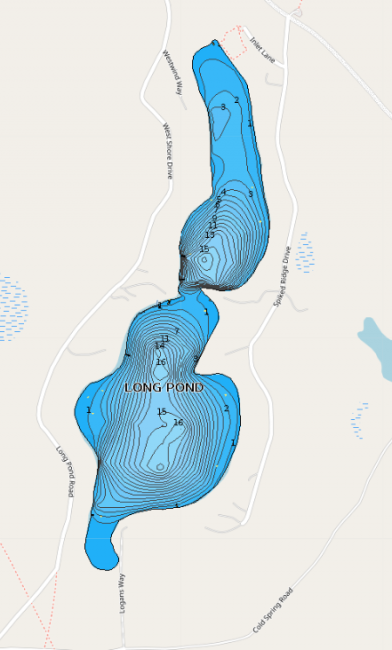Carry in access is available through a town lot, located on the southern shore of Long Pond.


Long Pond is a small, spring-fed pond in Denmark. It is located between the larger Pleasant Pond and tiny Beaver Pond. It is monitored by LEA staff once a year in August.
Long Pond was chemically reclaimed in September 1958, to remove competing species and permit more intensive management for brook trout. The successful reclamation along with a brook trout stocking program resulted in an excellent trout fishery. In 1984, both smelts and banded killifish were discovered in the pond. Both of these species compete with the brook trout. Some trout reproduction occurs around the springs and spring seepages on the north end of the pond. However, stocking is necessary to supplement this natural reproduction.
62 percent of soils in the watershed are type A soils. Type A soils tend to be well drained sands, loams, and gravels. When vegetation is removed and the soil is exposed they can be susceptible to erosion. Because they are often coarse with ample pore space, there is low runoff potential and water will not usually pool on them. These soils can be good places to site leach fields or infiltrate stormwater from a home or residence.
3 percent of soils in the watershed are type B soils. B soils have moderate infiltration rates and fine to moderate texture and soil size. They are usually made up silts and loams. Although not as well drained as A soils, they can also be good places to site leach fields and infiltrate stormwater.
3 percent of soils in the watershed are type C soils. C soils have low infiltration rates and typically have a layer that impedes the movement of water. These soils are made of sands, clays, and loams and are one of the most common soil types in western Maine.
5 percent of soils in the watershed are type D soils. D soils have a high runoff potential and very low infiltration rates. Soils with a high water table, clay or other impervious layer near the surface are typically D soils. These soils are often associated with wetlands.
9 percent of soils in the watershed are type C/D soils. C/D soils are a mix of these two soil types. They have fairly high runoff potential and low infiltration rates and often pool water.
The remaining 18 percent of the watershed is taken up by the pond.